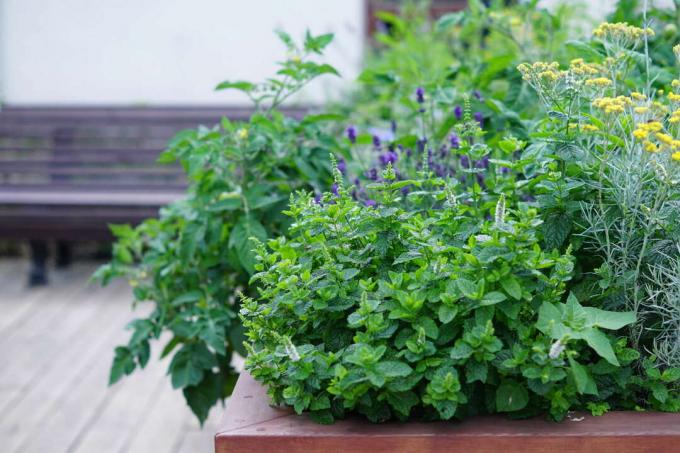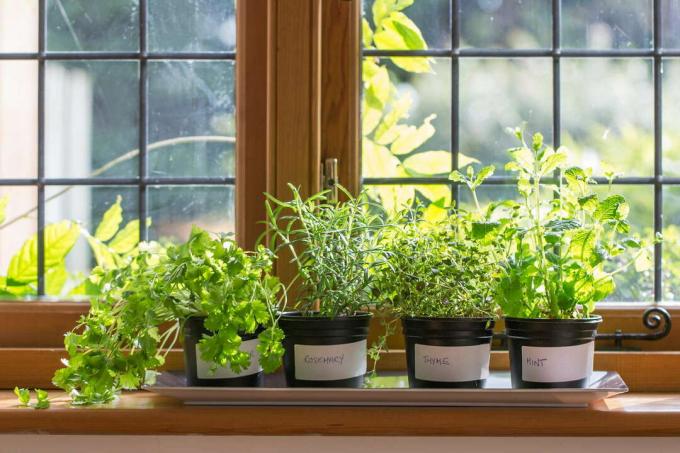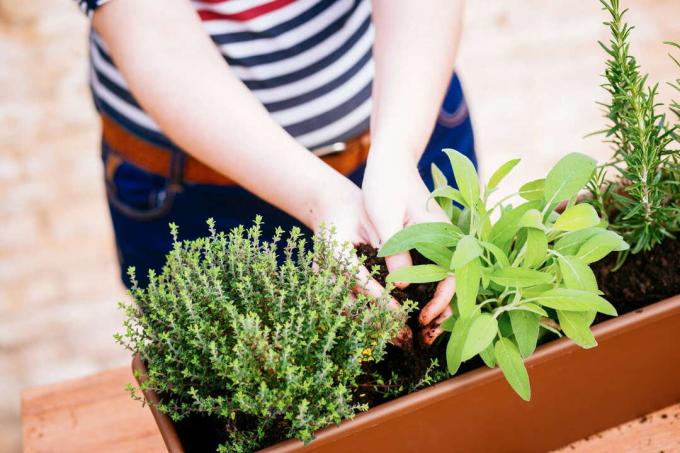Herbs are simply part of every good meal. How to plant herbs successfully (window sill, balcony and bed) can be found here.

Growing your own herbs is back in trend. After all, herbs are the spice of life and should not be missing in any garden. If you don't have enough space, you can easily grow your own herbs in the pot on the window sill or in the flower box on the balcony. We'll tell you which herbs are suitable for which cultivation method and what else there is to consider.
contents
- Planting Herbs: A Step-by-Step Guide
-
The choice of herbs
- Annual herbs
- Perennial herbs
- Mediterranean herbs for sunny locations
- Herbs for partially shaded locations
- Herbs for the window sill
- Herbs for the balcony
-
Herbs for the garden
- Herbs for the herb bed
- Herbs for the herbal raised bed
- Herbs for the herb spiral / herb snail
Planting Herbs: A Step-by-Step Guide
Many herbs can be planted both in the pot and in the bed. The main differences are in care. Due to the smaller volume in the root ball, potted cultures must be watered more frequently. In the garden bed, on the other hand, you should pay particular attention to the correct location and suitable overwintering of the individual herbs. The regular removal of weeds also takes a lot of time in the garden bed. If you want a quick harvest, you will in most cases prefer buying young plants to growing your own from seeds. Since the pots are often deeply rooted, the young plants should then be planted out as quickly as possible.
Planting herbs properly:
- Loosen the subsoil with a suitable substrate
- Dig a hole to a sufficient depth - the base should be at ground level after casting
- Remove the plant from the pot and place it in the hole
- Fill up with fine soil
- Pour immediately
The choice of herbs
Herbs can be roughly divided into annual and perennial plants. In addition, however, each herb has different requirements for its location. We will show you what to consider when planting the individual herbs and which species go well together.

Annual herbs
From a botanical point of view, plants are considered annual if they reproduce only once in a continuous vegetation period and then die. However, some of our plants are "annual" due to the lack of winter hardiness or the fact that they are bred for high yields. Annual herbs include dill (Anethum graveolens), chamomile (Matricaria chamomilla), coriander (Coriandrum sativum), Borage (Borago officinalis) and Nasturtiums (Tropaeolum majus). A common rule of thumb is that annual and perennial herbs should rather be left to themselves and not be put together. From a work point of view, this makes perfect sense, because many short-lived species prefer to change their location every year. But it is more important to pay attention to whether the neighboring cultivation is possible because of a possible increased susceptibility to diseases or because of growth-inhibiting intolerances. The most compatible representative among the annual herbs is probably that basil (Ocimum basilicum), it can even offer protection from pests and fungal diseases to its neighbors due to the essential oils it contains.
Perennial herbs
Well-known representatives of perennial herbs are thyme (Thymus vulgaris), oregano (Origanum vulgare), sage (Salvia officinalis), chives (Allium schoenoprasum), fennel (Foeniculum vulgare), Savory (Satureja hortensis) and tarragon (Artemisia dracunculus). Lemon balm is particularly well tolerated (Melissa officinalis) - you should only avoid the combination with basil, because the two don't like each other at all. Savory, oregano and sage, for example, are good neighbors among the perennial herbs.
Mediterranean herbs for sunny locations
Sunny locations are particularly suitable for growing Mediterranean herbs. These include savory, rosemary (Rosmarinus officinalis), Basil, lavender (Lavendula angustifolia), Oregano, sage or thyme.

Since many of these species come from the Mediterranean region, they prefer poor soils without waterlogging. When choosing plants for the garden bed, however, you should keep in mind that many Mediterranean herbs are not hardy.
The herbs that are not hardy include:
- basil
- Lemon verbena
- rosemary
- laurel
Herbs for partially shaded locations
Watercress (Nasturtium officinale), Dill, parsley (Petroselinum crispum), Fennel, tarragon, chives, Lovage (Levisticum officinale), peppermint (Mentha x piperita) and chamomile are not permanently dependent on sunshine. The east or west side of a house is ideal for cultivation. In addition, these plants mostly prefer humus, nutrient-rich and slightly moist soils.
Herbs for the window sill
It makes sense to plant the most common culinary herbs within easy reach. Because let's be honest: Who likes to stroll through half the garden in wet and cold weather to fetch a handful of herbs? In cities in particular, not everyone has their own garden or balcony - fortunately, most of them thrive in flower pots Herbs on the windowsill also wonderful.

Especially in winter we don't want to go without fresh, aromatic herbs in the kitchen. Chives and parsley, for example, can easily be potted in autumn and further cultivated in the kitchen window. With their fresh green and wonderful aromas, they help to dispel any gloomy mood in the dark months of the year. Mediterranean and not hardy herbs should be relocated to pots or tubs before the first frost so that they can be transported to their winter quarters.
Tip: A layer of gravel or potsherds under the substrate ensures that the irrigation water can drain off well and that no waterlogging occurs.
Pay attention to this when installing on the window sill:
- Repot occasionally
- Don't pour too much or too little
- Don't forget to fertilize
- Proper harvest to maintain a favorable habit
Tip: Herbs are particularly easy to grow with a growing kit. Our Plantura herb set contains everything you need to grow 5 aromatic kitchen herbs and is also ideal as a gift idea.
Herbs for the balcony
Larger pots and flower boxes will find a suitable place on the balcony. Depending on the orientation of the balcony, you should also consider the location requirements of the individual herbs here. A south-facing balcony offers the best sunshine, but the planters usually dry out faster and therefore have to be watered more often. The exact opposite is the case on a north-facing balcony: the lower solar radiation means that the water evaporates much more slowly. A balcony on the east or west side is therefore ideal for growing herbs that prefer partially shaded locations.

In addition to the optimal location and a suitable substrate, the size of the planters also plays a decisive role in the success of the cultivation. Some herbs - like dill and lovage - have quite deep roots and need a correspondingly high container. However, deep-rooted plants or plants with a particularly pronounced root system such as tarragon or wormwood are not suitable for the balcony.
Herbs for the garden
Herbs are not only used to give flavor in the kitchen, many are also attractive garden plants. Due to the mostly limited space available, the selection of herbs should be based on needs and intended use. Easy access to the plants also facilitates care and harvest.
Herbs for the herb bed
Especially in monastery gardens, the herb beds are often still laid out in a strict, formal style. The herbs are grouped together and planted in symmetrical beds. The beds are usually bordered by low hedges, fences or paths. Thanks to cleverly laid paths between the beds, the herbs can be reached quickly and with dry feet even in bad weather. Geometrically arranged beds are relatively easy to care for and a clear arrangement makes it much easier to find the individual herbs.

The following aspects must be taken into account:
- Not every herb grows in every location
- Do not mix annual plants with perennial plants
- Put tall plants in the center or in the background
- Plant drought-loving herbs on the edge
- Place overgrown plants in delimited areas
In a mixed culture with flowers, vegetables or fruit bushes, very harmonious compositions often result. Green, multicolored or beautifully blooming herbs - such as marigold, borage or purple marjoram - also fit wonderfully into ornamental gardens. Some herbs even influence the growth of other plants through their active ingredients, which you can definitely take advantage of in the vegetable patch. For example, basil between tomatoes, cucumbers and cabbage repels powdery mildew and whiteflies from vegetables. Conservable herbs such as chives and parsley can also be grown in larger quantities as required. A few specimens of aromatic plants such as tarragon and wormwood are usually sufficient.
Tip: Some herbs prefer to stand alone or should only be planted at a sufficient distance from other plants. Typical "loners" are lovage, Lemongrass (Cymbopogon citratus) and Wormwood (Artemisia absinthium).
Herbs for the herbal raised bed
If you prefer a raised bed instead of the usual garden bed, you can plant it with a wide variety of herbs. Most herbs do not have very deep roots. Therefore, a height of around 50 centimeters is usually sufficient for a raised herb bed.

If you want to put Mediterranean herbs in the raised bed, you should make sure that the lower layers drain off the water well when filling it. The optimal location of the raised bed depends on the herbs that are planted in it. Some species need a sunny spot, while others also feel comfortable in partial shade.
Tip: You can find detailed instructions for the Planting a raised herb bed.
Herbs for the herb spiral / herb snail
The herb spiral - or herb snail - is a modern and effective form of the herb garden. For this purpose, a mound of earth is created in a spiral or snail shape and, for example, enclosed with a small loose stone wall. The size of the spiral can vary greatly depending on the space available. The hill-like shape results in different habitats for the plants. At the foot of the spiral there is a place for moisture-loving herbs such as mint, parsley or chives. At the top of the spiral feel thyme and Quendel (Thymus pulegioides), which prefer a sunny and dry location, very much. On the shady north side you can find mint, cress, sorrel (Rumex acetosa) and chives. Opposite, on the sunny south side, Mediterranean herbs such as sage, rosemary and lavender thrive very well. In our special article we show you how to create your own in just ten minutes Create herb snail in the garden.

If you want to know which herbs go together, we suggest this article to you.



